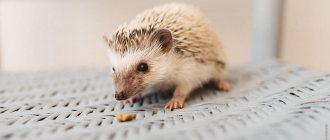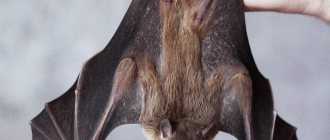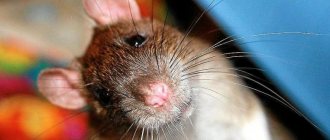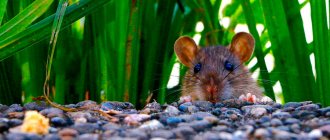In ancient times, mice were kept in monasteries and temples as sacred animals and were cultivated. A manifestation of this can be considered the fact that among many eastern peoples the first month of the calendar is named in her honor, although in some countries the mouse image was replaced with a rat one.
Some believed that these mammals could bring happiness. In Japan, there was a widespread belief that if you keep a white mouse in your home, it will rid the house of the attacks of its wild counterparts. In turn, astrologers in Ancient China used these rodents to make predictions.
But it was not only in the east that mice were cultured. Even if it was not whites, but brownies, they were revered in Ancient Greece. The image of a mouse was inextricably linked with the cult of Apollo, who was often depicted with a mouse sitting at his feet.
In some regions of Greece, Apollo was considered the patron saint of these rodents, and therefore they were kept in temples.
In other regions, he was considered a god who protected the homes of his admirers from the damage that these animals bring and from mouse invasions. There was even a myth about this.
Mass breeding of these animals began at the end of the 19th century, when the first batch of these rodents was imported to Europe for the purpose of scientific research. At the moment, they have become an indispensable resource for carrying out various experiments and the need for them does not fade over time.
White mouse: appearance of the species
The white mouse is a direct descendant of common house mice. As a species, it appeared about 3,500 thousand years ago. Now this is one of the most common types of rodents. They live everywhere except in permafrost regions and highlands.
The white mouse is a popular pet
For your information! Closest relatives are jerboas, hamsters, chinchillas
The white mouse was initially considered a noble and unusual animal due to its non-standard color. She was kept in houses and temples in China and Japan, as well as in Mediterranean countries. There, the image of a white mouse was sacred: it was not just bred for aesthetic pleasure, but was even worshiped. The adaptability and cleanliness of the animal, as well as the ability to be friendly towards representatives of its species, were noted.
Keeping animals began more than 1.5 centuries ago. ago, after their mass import to Europe for experimental research.
For more than a century, white mice have been used as experimental animals.
Contents: every mouse has its own hole
Each animal needs its own special space, which it will consider “its place” - sacred and inviolable. Therefore, before you bring mice home, you should take care of where they will live. It was before, not after. Because jars and cardboard boxes are absolutely not suitable for rodents. And any move is always stressful.
Avoid aquariums as well. They are cramped, stuffy, hot, the mouse will not be able to move normally in them and arrange a secluded corner for itself. The best solution would be a spacious cage with metal bars.
Rodent cage
Be sure to make it yourself or buy a small house - a hole where the mouse will spend all day long.
Add a wheel to provide your pet with physical activity and fulfill his need for movement. For the same purpose, take care of shelves, ladders and ropes. The animal will be happy to show you its dexterity, and you will also have fun watching its amusing movements.
Sawdust for rodents
Litter is a very important element. The layer should be quite impressive - at least 5 mm. Animals use it not only for its intended purpose, but also to decorate their house, and when there are drafts or low temperatures, they burrow into it to keep warm.
The material should be natural and preferably inexpensive: sawdust, dry peat crumbs, shavings, hay. Avoid cotton wool and sand - the first absorbs odors too well and gets tangled between your fingers, and the second can become a breeding ground for lice. But something tells us that you don’t want such neighbors.
Description of the size and character of white house mice
The white mouse is one of the small representatives of rodents.
What a mouse looks like - description of appearance and size
Appearance:
- size no more than 12-12.5 cm in length;
- the tail occupies over 50% of the entire body, 6-11 cm;
- weight 15-30 g;
- the muzzle is sharp, elongated;
- eyes large, round; they can be either dark or red (in albinos). They are characterized by excellent vision;
- The ears are small and round in shape.
Character
Mice are active creatures. They are in constant motion. If they are not running and climbing, then they wash themselves, gnaw, and dig.
Note! They are characterized by friendliness. There have been no recorded cases of aggressive behavior towards their relatives or other small animals. They can quite easily share their food with others.
White mice behave trustingly with people. Tamed individuals recognize the owner and can take food from their hands.
You need to hold the animal in your arms carefully
In relation to their offspring, white mice are caring parents. They not only do not abandon newborn mice, but take care of them, decorate the house for their offspring, and not only females, but also males do this.
Diseases
It is worth immediately noting that the life expectancy of rats is short - about two years. Under good living conditions, they can live for 4 years. Interesting fact: the maximum age of a rat that has been officially recorded is 7 years. If you keep more than one rat, then quite often fights will arise, which will lead to injuries. They need to be treated.
Sphinx and Dumbo rats are quite susceptible to various diseases, because this is a product of gene mutations, which later negatively affect their health. As a rule, old age for them begins at the age of two years.
Healthy rats are moderately active and inquisitive. They sniff their owner or his hands. If the rodent is too lethargic or, on the contrary, too active, then this indicates that it has health problems
When purchasing a baby rat, you should pay attention to the following points:
- scratches, wounds or sores on the paws and tail; later they can cause other more serious diseases;
- bald spots;
- suppuration on the body;
- frequent sneezing;
- a wet area around the anus is a clear sign of an intestinal disorder;
- any suspicious discharge from the eyes, ears and even nose.
Domestic rats differ from their wild relatives in much poorer health. The former are prone to gaining excess weight and various cancers. To prevent these diseases, it is necessary to carefully monitor your pet’s diet. Separately, it is worth highlighting ticks, lice and other parasites that live on animals covered with hair. To get rid of them, it is necessary to detect the disease in time and treat the animals with special preparations.
What to feed white mice at home
White mice are unpretentious in food. Despite this, it is very important to maintain a balanced diet, as with any animal.
White ferret - description of the species, size and character
A rodent's diet may include:
- grain crops (oats, millet, barley, millet, corn);
- pumpkin, sunflower, flax, hemp seeds;
- vegetables (cabbage, root vegetables);
- fruits (apples, pears);
- green plants (leaves and stems);
- cottage cheese;
- boiled milk;
- animal food: mealworms or other invertebrates, some boiled meat;
- special granulated food for mice. Particular attention should be paid to the composition of the product. It should not contain harmful chemical dyes.
It is important to periodically add vitamin and mineral complexes to the diet to maintain and improve the animal’s health. This is especially useful and necessary for pregnant and lactating individuals.
Important! Salty, fatty, spicy, smoked and fried foods, as well as confectionery sweets, are strictly contraindicated for pets.
White mice should be fed no more than once a day. The norm is 1 teaspoon per individual. The mice are given unboiled tap or well water, but most importantly, clean water.
Decorative rodents
Selection has provided hundreds of different subspecies of mammals that sing and “waltz,” differing in their specific coat tone.
There are albino animals, and there are black, ash, and cream colored animals.
When choosing an animal, give preference to the following breeds of domestic mice:
- A miniature Japanese mouse, no more than 5 cm long, whose white skin is decorated with black and brown spots. Friendly and clean, she is a supporter of the nocturnal lifestyle and gives birth to up to 7 cubs.
- Spiny mice with needles on their back. It is reddish-brown or blackish-red in color. There is a hump of fat on the neck. It has an elongated nose, bulging eyes, and oval ears. The active animal loves people and becomes attached to them.
- A striped African specimen with an interesting coloration of light and dark stripes. It does not emit a smell and likes to climb on vertical surfaces. The mouse is extremely cowardly. Sensing trouble, she pretends to be lifeless or jumps up to two meters high. Does not grow longer than 10 cm.
Features of care and maintenance of white mice at home
White Swiss Shepherd: description of the breed
Caring for white mice itself is not difficult. They are quite unpretentious creatures. Animals can be tamed quite quickly. Starting from the age of one month, the mouse can already be picked up. Soon he himself will recognize the owner and go into his arms. Tamed animals are easy to train - make them perform all sorts of tricks.
Important! When breeding white mice, it is necessary to take into account that they emit a specific smell that not everyone can tolerate, especially when there are many individuals in a small area.
Much attention must be paid to the animals’ housing. The habitat of rodents must be at least 40x40 cm in size for one individual. If you plan to have a couple or three individuals, then the home should be more spacious.
You can place the animal in a cage, a special plastic box or an aquarium. It is worth paying attention that the space between the bars of the cage does not exceed 10 mm, otherwise the rodent will easily and quickly slip through the gap and get lost in the corners of the apartment.
When using an aquarium, the top must be covered with a special lid with ventilation holes or a mesh. The floor of the home must be covered with paper and sprinkled with shavings, sawdust, and hay.
Note! It is also necessary to take into account the location of the cage. Do not place the house with mice in a draft or near the heating system. The temperature in the room where animals are located should not exceed 20-22 ° C, air humidity - 50-60%.
A small container, preferably made of durable material, should be placed in the cage itself. This will create a kind of cozy mink. It is advisable to place perches or shelves for climbing and a running wheel in the mouse house. This will allow the animals to be active and not become fat in captivity.
It is better to use a feeder made of durable material. Special automatic devices in the form of glass tubes with a spout extended to the side are very convenient as drinking bowls. In addition to the main food, you can add hard bread, sticks, and twigs to the feeder, since mice have to sharpen their teeth.
Even when in captivity, mice need to move
Don’t forget to wash the rodent’s house with water and change the bedding in it more often.
Important! You should not place mice of the opposite sex in the same cage unless you plan to breed rodents. These animals are capable of constant and uncontrolled reproduction.
Don’t forget that mice are nocturnal animals, but over time they can adapt to a person’s routine. These rodents sleep on average about 10 hours a day.
Mice, like other living creatures, are susceptible to diseases. The most common among them are such serious diseases as tumors, cystitis, parasitic infections, otitis media, smallpox, salmonellosis, etc. If you suspect a problem, you should immediately contact a veterinarian.
In Russia, white mice are often kept as pets. Sections and clubs for lovers of these decorative rodents are being created. Despite the specific smell, the animal is popular among breeders because it is unpretentious in keeping and feeding. Their curiosity and friendliness are also valued.
Sense organs (eyes, ears and teeth)
The bat's eyesight is poor, but its ears can detect the slightest rustle several meters away. The auricle is huge.
Before flying, pushing off from the surface, the animal emits a piercing squeak, which, when it encounters an obstacle, returns. This echolocation allows one to navigate at night and serves as a technique for catching prey.
Eyes of medium size. Set on the front of the muzzle. Vision is black and white. When sunlight appears or imitates it, the bird experiences pain.
The jaw consists of incisors, molars, premolars, and canines. The pungency, shape and quantity depend on the nutrition of the chiropteran creature:
- in insectivores - 38, long, shaped like mortars;
- bloodsuckers have 20–26 teeth, sharp, large on a well-developed jaw.
Training of decorative rats
The variety of types of games with a rat will surprise you
Decorative rats have a natural intelligence, which makes them easy to train. It has been noticed that individuals with colored fur are more capable of learning. White rats are more inert. In addition, their eyesight is worse.
Rules for training decorative rats:
- The last meal should be 10–12 hours before the start of classes. In this case, the pet will be more active in seeking the treat.
- The maximum lesson duration is 30 minutes.
- Before starting training, the animal is given the opportunity to sniff and explore the place where the lesson will take place. In this case, the rat will not be distracted by unknown odors.
- Training is carried out starting with the reinforcement of random movements and actions. If the pet jumps over any object, reward it with a treat and return it to its original position.
- They complicate the task only after the previous actions have been fully practiced and consolidated.
Tricks that decorative rats can perform:
- jump over an object;
- jumping through a hoop;
- searching for treats in the maze;
- walking on hind legs;
- taking a piece of paper out of the box;
- choosing a specific item from several located next to each other;
- running up stairs (including rope stairs).
Playing together brings pleasure to both the owner and his pet. Most popular toys:
- small balls (ideally from table tennis);
- beautiful pieces of paper;
- matchboxes filled with treats.
Watching your pet play is interesting and educational. The game reveals the character of the rat, and the owner begins to better understand his pet.
There are many tricks that complement the natural habits of rodents and will bring pleasure to the owners. To do this, you will need a treat - a piece of meat, a pumpkin seed. How to train a decorative rat:
- Return to the cage. After the animal has taken root, it can be released for a walk around the apartment. It’s easy to return the animal: at the same time you need to sprinkle food, knock the bowl on the floor and call your pet - he will come running.
- “Sit” or “serve.” You need to hold the treat over the animal’s head and say the command. The rat will learn that it gets a treat after it stands on its hind legs and will follow the order to “sit” every time, even without a treat.
- Run in circles. You can move the treat along a trajectory and give it to the animal after it completes the trick. Also, with the help of treats, it is easy to teach a rat to run up stairs.
The process of training rats is simplified due to their friendliness. Individuals can be easily tamed to climb into and out of their owner’s long sleeves. Rats love to rummage through boxes and find things there. By regularly rewarding and stroking them, rats can be taught to fetch small items or jump over obstacles. Rodents can also easily learn to climb a rope or hoop.
Of course, you should never hit your pets. Such behavior towards him will not give any results in terms of training. Among the simplest tricks that you can teach a rat is to respond to its name and come to its owner, and also to stand on its hind legs when ordered. Quite often, sunflower seeds or small pieces of fruit are used as rewards.
Moving away from the topic, I would like to talk about the origin of domestic rats. The 16th century, when rats filled all medieval cities, is a thing of the past, but it is from this moment that their domestication begins. Human breeding of rats reached its peak in the 19th century, when individuals were bred specifically to participate in battles. During the same period, albinos began to be used for laboratory research.
Of course, not all rats took part in battles or were experimental subjects; some individuals remained with people as pets. Since then, they have lived next to people, and their disposition has become more docile than that of their wild relatives.
To learn how to care for a rat, watch the following video.
Dental system
Rodents have well-developed incisors: two pairs on each jaw. The front teeth have no roots and grow throughout the mouse's short life. To prevent excessive growth, mice must constantly grind them down. The upper incisors are much larger than the lower ones, and are covered with durable enamel on the front.
Pests do not have fangs; instead, the jaw has a toothless edge - a diastema, behind which there is a palisade of molars. With their help, food is ground and crushed. The surface of some teeth is smooth, while others are covered with tubercles. Like incisors, molars are constantly growing and need to be ground down. Tree branches are perfect for these purposes.
When trying to gnaw on something metal or hard, the lower incisors may break, which leads to an incorrect bite: the teeth of the upper jaw bend inward, the animal is unable to close its mouth, cannot eat, and as a result dies from starvation.











